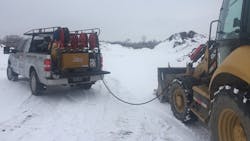Mobile lube service aids winter maintenance
Work doesn’t grind to a halt just because temperatures drop. Although some may race against time to see how much work can be done before the snow flies, many fleets work through the winter. To maintain equipment productivity during these cold months, fleet managers cannot delay preventive maintenance until the spring thaw.
Content provided by Sage Oil Vac.
Plummeting temperatures also affect field service technicians. Although changing oil in cold weather is necessary, it can take a toll on both machines and people. Working in subzero conditions quickly induces fatigue. And as the mercury drops, oil thickens, and equipment is more reluctant to turn over due to the increased oil friction resistance and decreased battery efficiency.
Transporting equipment from the job site to a heated shop to perform maintenance and give technicians a comfortable place to work is not always an option for fleets. Equipment is integral to a job site’s overall operation, and the time and cost to transport equipment to the shop and back results in lost productivity. This can quickly erode revenue potential.
It is often simply more cost-effective to service equipment on the job site, even in cold weather. Mobile lube service offers one method to effectively maintain equipment during the winter months by protecting both technicians and equipment as temperatures drop.
Winter benefits for technicians
Working long hours to finish changing oil in cold weather can be unbearable with a subpar lube truck setup. Using buckets to change oil further complicates the task and exposes technicians to hot oil. The right tools for the job make all the difference.
Using a closed-loop system with quick disconnects protects technicians from oil exposure and reduces manual effort while they battle the weather. Less physical effort in subzero temperatures means more productive technicians.
Options for enclosed trailers, enclosed trucks, or even a custom system can also simplify changing oil in cold weather. Heated fluid tanks that use immersion heaters can increase productivity. Coolant circulates through probes in these tanks, transferring heat to the oil and enabling easier oil changes as outside temperatures plummet.
Tips for cold weather oil changes
Oil viscosity is the key differentiator in cold-weather operations. The viscosity needs to be thick enough to prevent metal contact while being thin enough to prevent excessive energy loss.
Temperature changes can influence oil viscosity, which makes changing oil in cold weather more difficult. The oil must remain sufficiently viscous at high temperatures, but it can’t be too thick at low temperatures. It also must remain robust across a wide temperature range to handle cold starts in the winter and normal internal operating temperatures.
Read also: Oil management for maintenance ROI
When selecting the appropriate oil, pay particular attention to the number before the W in the oil specification. That number stands for the winter viscosity. A lower number means it is more fluid at a colder temperature. For instance, a 5W-40 engine oil is thinner in cold temperatures than a 10W-30.
Consult the equipment owner’s manual and use the recommended oil for the temperatures. Equipment operator manuals may suggest different oils for varying temperature ranges.
Warm engines for effective results. Never perform ‘cold’ oil changes, regardless of the weather outside. Best practice dictates oil should always be warm so it flows freely and drains completely.
Start the engine and warm it up to normal operating temperature to circulate the oil prior to the oil change or perform the oil change shortly after the equipment has been shut down for the day. Running the engine immediately prior to an oil change also helps ensure better removal of contaminants from inside the engine. Contaminants from wear, the combustion process, and the environment are suspended in the oil when the machine is working.
Shortly after shutting the machine down, these contaminants settle out to internal surfaces and the bottom of the oil pan. If oil is changed after the engine has been at rest, these contaminants will likely adhere to the internal engine surfaces.
About the Author
Aaron Sage
Aaron Sage is CEO of Sage Oil Vac.
